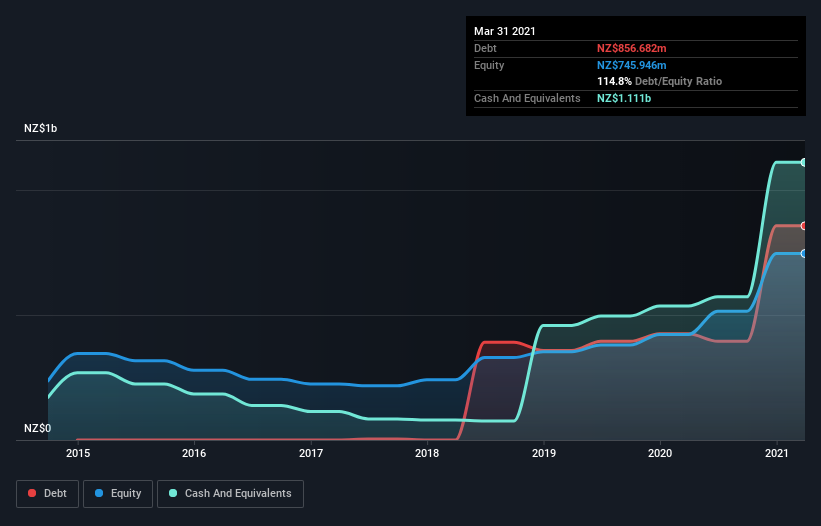These 4 Measures Indicate That Xero (ASX:XRO) Is Using Debt Safely
Warren Buffett famously said, 'Volatility is far from synonymous with risk.' It's only natural to consider a company's balance sheet when you examine how risky it is, since debt is often involved when a business collapses. As with many other companies Xero Limited (ASX:XRO) makes use of debt. But the real question is whether this debt is making the company risky.
What Risk Does Debt Bring?
Generally speaking, debt only becomes a real problem when a company can't easily pay it off, either by raising capital or with its own cash flow. Ultimately, if the company can't fulfill its legal obligations to repay debt, shareholders could walk away with nothing. However, a more usual (but still expensive) situation is where a company must dilute shareholders at a cheap share price simply to get debt under control. Having said that, the most common situation is where a company manages its debt reasonably well - and to its own advantage. The first step when considering a company's debt levels is to consider its cash and debt together.
Check out our latest analysis for Xero
What Is Xero's Net Debt?
The image below, which you can click on for greater detail, shows that at March 2021 Xero had debt of NZ$856.7m, up from NZ$424.6m in one year. But it also has NZ$1.11b in cash to offset that, meaning it has NZ$254.0m net cash.
How Healthy Is Xero's Balance Sheet?
The latest balance sheet data shows that Xero had liabilities of NZ$168.8m due within a year, and liabilities of NZ$1.11b falling due after that. Offsetting this, it had NZ$1.11b in cash and NZ$35.0m in receivables that were due within 12 months. So its liabilities total NZ$132.4m more than the combination of its cash and short-term receivables.
This state of affairs indicates that Xero's balance sheet looks quite solid, as its total liabilities are just about equal to its liquid assets. So it's very unlikely that the NZ$22.6b company is short on cash, but still worth keeping an eye on the balance sheet. While it does have liabilities worth noting, Xero also has more cash than debt, so we're pretty confident it can manage its debt safely.
It is well worth noting that Xero's EBIT shot up like bamboo after rain, gaining 81% in the last twelve months. That'll make it easier to manage its debt. When analysing debt levels, the balance sheet is the obvious place to start. But it is future earnings, more than anything, that will determine Xero's ability to maintain a healthy balance sheet going forward. So if you want to see what the professionals think, you might find this free report on analyst profit forecasts to be interesting.
But our final consideration is also important, because a company cannot pay debt with paper profits; it needs cold hard cash. Xero may have net cash on the balance sheet, but it is still interesting to look at how well the business converts its earnings before interest and tax (EBIT) to free cash flow, because that will influence both its need for, and its capacity to manage debt. During the last three years, Xero generated free cash flow amounting to a very robust 83% of its EBIT, more than we'd expect. That positions it well to pay down debt if desirable to do so.
Summing up
While it is always sensible to look at a company's total liabilities, it is very reassuring that Xero has NZ$254.0m in net cash. And it impressed us with free cash flow of NZ$57m, being 83% of its EBIT. So is Xero's debt a risk? It doesn't seem so to us. When analysing debt levels, the balance sheet is the obvious place to start. However, not all investment risk resides within the balance sheet - far from it. For instance, we've identified 4 warning signs for Xero (1 is concerning) you should be aware of.
If, after all that, you're more interested in a fast growing company with a rock-solid balance sheet, then check out our list of net cash growth stocks without delay.
This article by Simply Wall St is general in nature. We provide commentary based on historical data and analyst forecasts only using an unbiased methodology and our articles are not intended to be financial advice. It does not constitute a recommendation to buy or sell any stock, and does not take account of your objectives, or your financial situation. We aim to bring you long-term focused analysis driven by fundamental data. Note that our analysis may not factor in the latest price-sensitive company announcements or qualitative material. Simply Wall St has no position in any stocks mentioned.
Have feedback on this article? Concerned about the content? Get in touch with us directly. Alternatively, email editorial-team (at) simplywallst.com.

 Yahoo Finance
Yahoo Finance 
